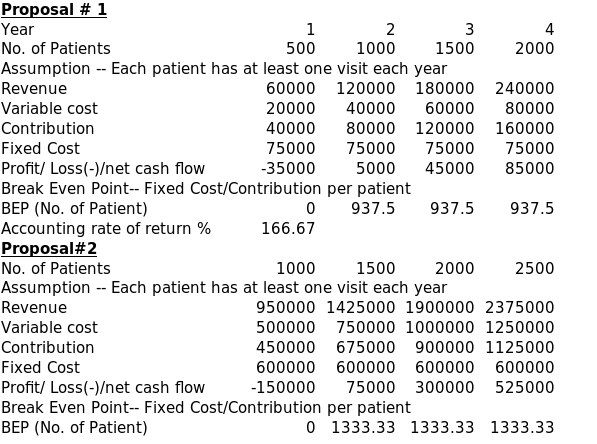Introduction
Two proposals of investments by Health Care Medical Center are different in nature not only in their functioning but also so far as initial outlay is concerned. Three methods used for evaluating the proposals and for taking a decision between the two investments are breakeven point method, payback period method, and accounting rate of return. The calculations used for evaluating each method are made in the first section to discuss breakeven method.
Calculation of Breakeven point

Break even analysis is also called cost- volume- profit analysis. This method is used to find out the level of operations that are required to meet all operating expenses. This method is also used to find out profitability that is associated with different levels of revenue or sales. The breakeven level is the stage level of sales covers all necessary operating expenses. In other words it is a no profit no loss situation. For this purpose the expenses or costs are divided into two, one as variable cost and the other as fixed expenses. Variable costs vary with the sales and on the other hand fixed expenses remain static for a period of time or upto a stage of sales or production.
“Breakeven point is one of the most commonly used concepts of financial analysis for entrepreneurial decisions.”(Satya Prakash Singh and Jayant V Deshpande). Break even is the point where the contribution from revenue after meeting variable cost is exactly equal to the fixed cost of the enterprise during that period or project under consideration. The above chart shows that Health Care Medical Center is not breaking even in the first year under both the proposals. In the first proposal contributions after meeting variable costs from 937.5 patients and in the second proposal from 1333.33 patients meet the fixed costs during the second year, and this happens only in the second year of operation under both the proposals.
Identification of payback period
“The Payback period is the exact amount of time required for the firm to recover its initial investment in a project as calculated from cash inflows. In case of an annuity, the payback period can be found by dividing the initial investment by annual cash inflows. For a mixed stream of cash inflows, the yearly cash inflows must be accumulated until the initial investment is recovered.” (Lawrence J Gitman)
For the purpose of making a decision about acceptance or rejection of investment projects, the criteria to be followed under payback period method is as under:
- Accept the proposal if the payback period from that proposal is less than maximum acceptable payback period. The decision about maximum acceptable period is the decision of the management.
- The proposal will be rejected if payback period from the particular proposal is greater than the maximum acceptable payback period.
The initial investment in proposal # 1 is $15000 and that is being recovered from the cash inflow from first year revenue of $60000, though the net cash flow is a negative figure. Payback period is not concerned with net cash inflow but with gross inflow from sales or revenue.
In case of Proposal # 2, the initial investment is $50000 and that is also being recovered from revenue of $950000 in the first year. Comparing the two proposals from the payback period point of view, the initial investment in proposal # 1 is lower than initial investment in proposal # 2, and therefore proposal # 1 is preferable as its investment will be recovered earlier than that of proposal # 2 in the very first year.
Profitability
Accounting rate of return method is used to evaluate the profitability of both the proposals over a period of four years. The calculations made in the chart above are based on the average profits earned under each proposal during the period of four years.
It may be noted that proposal # 1 as well as proposal # 2 show losses in the first year and only 2nd year onwards these proposals are profitable. The accounting rate of return calculated above shows that such rate of return under proposal #2 is greater than that of proposal # 1. This accounting rate of return is calculated on the basis of average profit for all the years. Though grossly proposal #1 will earn $100000 in four years and proposal # 2 will earn $750000 but accounting rate of return of return is also greater in proposal # 2. Under some quarters it is believed that accounting rate of is not a sophisticated technique. The reason is that it is calculated by taking into account the average profits of the project, and also the accounting rate of return does not take into consideration the cash flows.
Conclusion
There is some similarity in proposals so far as breakeven point and payback period is concerned. But from the point of view of accounting rate of return the proposals are vastly different. Under each method proposals are evaluated using different concepts that are not comparable. But a decision is required taking into consideration the totality of the proposals.
From three methods of selecting a proposal discussed above, it is clear that proposal #2 clearly stands out even though break even is achieved in the first year itself under both proposals and also the payback period is first year for both proposals. The accounting rate of return in proposal # 2 is 375% as compared to accounting rate of return of 166.67% in proposal # 1 in the total period of four years. This big difference in accounting rate has made the big difference in decision making, even though a decision based on net present value of cash flows is always preferable.
Reference
Satya Prakash Singh and Jayant V Deshpande, Break Even Point, Economic and Political Weekly, Vol 17, No. 48 (1982) Web.
Lawrence J Gitman, Principles of Managerial Finance, ninth edition, Capital Budgeting Techniques, Pearson Education, page 377